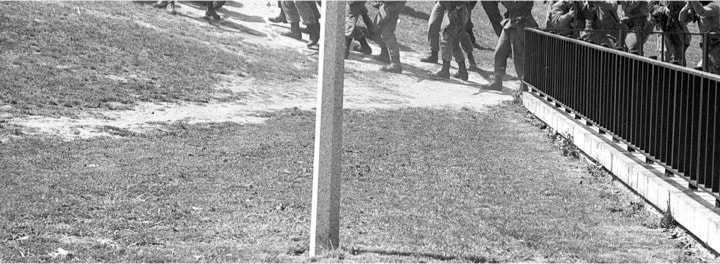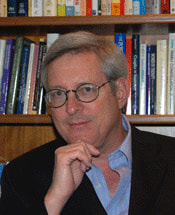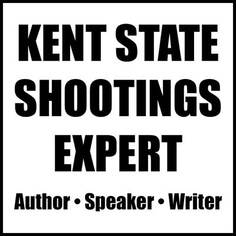Rocks. Rocks. What Rocks?: A Damning Photograph Confirms Kent State Shootings Were Unnecessary8/23/2019 A brief write-up of Moments of Truth: A Photographer’s Experience at Kent State, 1970. (Kent State University Press: 2019 ($34.95).
Howard Ruffner did something very clever in his just-published collection of photographs taken at Kent State just before and during the May 4, 1970 killings. Ruffner, a photographer and stringer for Life magazine (where some of his photographs originally appeared), enhanced his famous photograph of the Guardsmen turning and preparing to fire on the students. As Ruffner notes, his enhanced photographs show a complete absence of rocks by the feet of the Ohio National Guardsmen. For those who are old enough to remember the campus killings, Ruffner's photographs just demolish the Ohio National Guards' claims that they were pelted with rocks and other objects before they fired to protect themselves from a lemming-like crowd of crazed students. Ruffner's photographs may be the most damning evidence that the Guardsmen did not tell the truth and the four fatalities did not deserve to be killed. The rest of Ruffner's photographic memoir consists of a brief retelling of his background, a review of how he became one of the most important witness for the victims during both the criminal proceedings and a civil trial alleging wrongful death and injury. He also provides other photographs taken both before the shootings, and in its immediate aftermath, and in the four days following President Richard Nixon's announcement that he was sending combat troops into Cambodia, which many students considered to be an expansion of a hated war. Ruffner’s book is a welcome addition to the literature on the tragedy, and reminds us that while there might be plenty of "moments of truth," we still do not why a faraway war came home to America's campuses.
0 Comments
Kent State Audio Experts Allege FBI Lab's Analysis of Tape Based on 'Beyond antiquated' software4/30/2013 The FBI has finally released a summary of its report showing how it tested the tape of the Kent State shootings, and the summary confirms that the tests used to dispute two audio experts' claims that there was a "prepare to fire" order were based on technology that is "beyond antiquated."
That is what audio forensics expert Stuart Allen told me after I read to him the summary the FBI report made available after numerous Freedom of Information Act requests. The report states that the FBI used RAP-R 2, SoundForge3, AvidPro Tools, AdobeAudition3, and ES-4 as opposed to SoundForge10 and the more advanced Russian S.I.S. Sound Cleaner. Allen's fellow forensics expert Tom Owen similarly dismissed the FBI's tools as "off the shelf vendor stuff" that cannot replicate the results Allen and Owen obtained. At issue here is whether or not a command "prepare to fire" was issued by someone in the Ohio National Guard shortly before the troops fired into a crowd of protestors at Kent State on May 4, 1970, killing four students and wounding nine others. The soldiers denied under oath at the 1975 civil trial that any such orders were issued, and if Allen and Owen's interpretations are correct, it means at a minimum there was extensive perjury at the trials. Some survivors of the May 4, 1970 tragedy believe that it also proves the Guard committed murder. A presidential commission in 1970 concluded the shootings were "unnecessary, unwarranted, and inexcusable." Although most of the contributing causes of the May 4, 1970 killings have been identified, the precipitating cause remains the subject of debate. The controversies surrounding the killings are not acknowledged in the university's new May 4 Visitors Center, which will be celebrated this Saturday, the 43rd anniversary of the killings, with panel discussions and a speech by filmmaker Oliver Stone. There is a professor at Kent State who has a rather nasty habit of sabotaging anyone he perceives as a professional threat. Although he does not dare say anything publicly, he has been quietly trying to discredit his competitors by claiming their work is riddled with errors.
For example, in 1990, when American History Illustrated published a 20th anniversary article he wrote, he tried to convince Geneva Politzer, the magazine's editor, not to publish an accompanying article by freelance writer Lesley Wischmann. The professor vehemently claimed her article contained numerous errors of fact. Politzer then asked Lewis to prove his claim by itemizing these supposed mistakes. When push came to shove the professor had to back down and admit he could not even cite one single example. Wischmann's article was subsequently published and, would not you know it? Neither I nor anyone else found any errors or problems with anything she wrote. Word also reached me that the professor emeritus, Jerry M. Lewis, has been conducting a whispering campaign against my book, making the same unsubstantiated charges. Again, he would only talk in generalities and could not cite one single example. It was, of course, deliberate slander, pure and simple. One of the reasons Lewis' lies infuriated me is that I take great pride in my journalism. In the 22 years since my book was originally published, no one--not a single scholar, journalist, or groupie--has ever identified any error of fact, either significant or nitpicking. No one has ever claimed I misquoted them or did not accurately report what was in any historical documents. No one has ever suggested that I was less than conscientious with the mountains upon mountains of raw material that attorneys deliberately created and preserved for historians to study. And, of course, I am still the only chronicler of this event who has actually studied and written about them. The failure to find errors in my book is something that cannot be said about most other books about the killings, including books by two Pulitzer Prize winners, James Michener and Philip Caputo. Kent State professors, fellow journalists, and attorneys for the defendants found numerous problems with Michener's reporting, and Caputo committed a few sloppy errors that his more radical critics blew out of proportion because he was not one of them. I have no problem with people disagreeing with my conclusions. May 4 certainly was not a black-and-white case, and disagreements are to be expected any time a writer tackles a highly controversial cause celebre. But as far as my basic reporting is concerned, I feel I deserve to be commended for treating an enormous body of evidence in such a conscientious manner. Instead, I found myself the subject of a smear campaign, and I do not like it one bit. A few things need to be said here. First, Lewis has several reasons to be unhappy with my book. Not only did I not praise his scholarship, but I skewered his tortured subdisciplinary reasoning for recommending the main campus memorial be built. While others felt the memorial was needed because four students were killed in a tragedy a presidential commission called "unnecessary, unwarranted, and inexcusable," Lewis felt a memorial was needed because it "sensitized America to regimented lines of communication and authority. May 4 changed forever how future demonstrations--peaceful or otherwise--must be perceived, analyzed, understood. and settled nonviolently." I also ridiculed him and his colleagues for their obstinate refusal to acknowledge the real debate. I also did not feed his supersized ego. One year Jerry, apparently confusing himself with a celebrity, actually gave his students a handout of his schedule of his upcoming TV appearances. And perhaps most importantly, my book contains some highly embarrassing revelations about the ethically challenged professor. On pages 256 and 257 of the paperback edition, the book reveals how, in just a matter of a few days, Lewis politically shapeshifted from a champion of campus radicals who opposed a federal grand jury investigation, to someone who voluntarily became a secret informant against the victims. Jerry briefed then KSU President Glenn A. Olds about a confidential meeting among the victims in which their legal strategy was discussed. Four Dead in Ohio discloses a document I discovered in the archives which demonstrated this happened at a time when the victims were suing the university. It was akin to someone infiltrating a legal defense. Jerry did this after he spoke out in defense of the radicals who opposed the grand jury investigation (which the victims sought), and was roundly humiliated by Arthur Krause, the father of slain student Allison Krause, who exploded: "Jerry, that is the stupidest thing I've ever heard!" Lewis kept quiet for the rest of the meeting, but he later retaliated against Krause by briefing Olds and again later by telling me that Krause was crying on cue during a television interview, as if Krause was faking his grief. And, of course, Jerry has also been threatened by my research. I did not quite understand why he urged me so strongly to give up seeking publication until the president of a U.S.-Canadian textbook distribution company told me that my book was perfect for classes in "Social Problems." That happens to be Lewis' field of expertise. Incidentally, he assigned his own May 4 textbook in that class. Jerry will not be happy to hear that my book has been adopted for classes at nine or ten universities. I hope there are a few professors at Kent who are wise enough to challenge Lewis the next time he pulls this crap. As far as I am concerned, he is shamelessly intellectually dishonest. And an absolute disgrace to his profession. POSTSCRIPT My recommendation for a new word in The American Heritage and other dictionaries: to "jerrylewis" someone Definition: To sabotage one's competitor, especially one who has far surpassed his own work. Yes, he wants to be the leading expert on the Kent State shootings so badly that I am going to oblige him. I intend to make him into a household name. I finally got around to talking with Raymond Srp, the captain of Troop G of the 107th Armored Cavalry, the National Guard unit which did most of the firing at Kent State. When I asked him what he thought about Stuart Allen's finding that the Guardsmen were ordered to fire, Srp still maintained that there never was such an order and the Guard only communicated with hand signals because of all the noise at the time of the shooting.
As Srp tells it, when the shooting broke out, he had his back to his men because he was marching ahead of them trying to see what lie ahead beyond the crest of Blanket Hill. (There was nothing blocking the Guards' retreat.) His story was that the shooting was the result of the rock throwing and that his sergeant, Myron Pryor, who was accused by Peter Davies of starting the shooting, never fired his weapon, even though he certainly appeared to be caught in the act in the famous John Darnell photograph. Srp told me that he personally checked Pryor's gun after the shootings and determined it had not been fired. The reason why, Srp claimed, was that Pryor's hand was swollen from a previous incident in which Pryor tried to demonstrate to the other soldeirs in the unit how to correctly fire a tear gas cannister. As Srp tells it, Pryor somehow screwed up and had the tear gas cannister accidentally recoil onto his hand. That, Srp claimed, made Pryor's hand swell and made it impossible for Pryor to cock his .45. Since I a not an expert on weaponry and tear gas, I could not explore that issue any further. HISTORICAL NOTE: Srp was originally quoted in the Justice Department's summary of the FBI report as saying the Guardsmen's lives were not in danger and that it was not a shooting situation. However, after his lawyers coached him, he changed his testimony at the wrongful death and injury trial to say that the situation was becoming more dangerous. |
AuthorThis blog is written by William A. Gordon, a Kent State alumnus and the author of "Four Dead in Ohio" and three other books. It offers commentary on the still unfolding developments in the Kent State shooting case. Archives
March 2020
Categories
All
|
|
Kent State Shooting Expert
William A. Gordon Email: [email protected] Website: www.KentStateShootingsExpert.com |


 RSS Feed
RSS Feed
